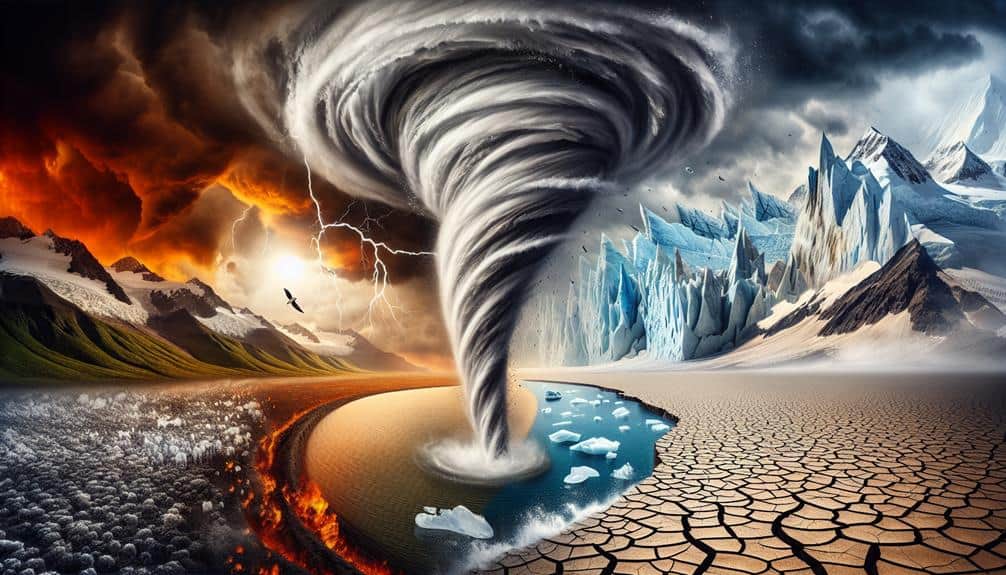Climate change's impact on storm chasers is profound. We're observing more frequent and intense storms driven by rising global temperatures. Shifts in storm patterns cause erratic behavior and altered paths, complicating our forecasting and data collection efforts. Enhanced storm intensity demands robust equipment and real-time data. Safety concerns escalate as storms intensify, requiring rigorous risk management and emergency protocols. Advancements in technology, such as drones and algorithms, are essential for adapting to these challenges. By continuing, further insights into adapting to these evolving conditions and their broader implications will be revealed.
Key Points
- Increased storm frequency demands more robust and real-time data collection equipment for storm chasers.
- Changing storm patterns make predicting storm paths more challenging for storm chasers.
- Enhanced storm intensity requires storm chasers to modify their equipment and strategies to withstand stronger storms.
- Safety protocols for storm chasers must be continually reassessed due to the increasing risks from intensified storms.
Increased Storm Frequency
The data indicates that climate change is noticeably increasing the frequency of severe storms, thereby impacting storm chasers' activities and strategies. We observe a direct correlation between rising global temperatures and the number of intense weather events. This surge compels us to adapt our chasing strategies to ensure safety and maximize data collection.
First, the increased storm frequency means we're encountering more opportunities to observe storms, yet it also demands heightened awareness of environmental effects. Our equipment must be more robust to withstand harsher conditions. Real-time data becomes vital, requiring advanced meteorological tools to track storm developments accurately.
Moreover, the environmental effects of frequent storms include more significant damage to infrastructure and natural landscapes, which can impede our mobility and access to storm sites. Roads might be blocked, and communication lines could be down, necessitating pre-planned alternative routes and reliable communication systems.
Additionally, we must consider the broader implications of our activities on the environment. Increased storm chasing could worsen carbon footprints, so integrating sustainable practices into our operations is crucial. By refining our strategies and acknowledging these environmental effects, we can continue our pursuit of understanding severe storms while being mindful of the changing climate.
Changing Storm Patterns
As climate change progresses, we're observing notable shifts in storm patterns that influence our forecasting models and field operations. Data indicates that storm behavior is becoming increasingly erratic, with storms forming in regions previously considered low-risk. This unpredictability challenges our storm tracking efforts, forcing us to adapt and refine our techniques on the fly.
We've noted a significant alteration in the seasonal distribution of storms. Traditionally, storm seasons had relatively predictable timelines, but climate change has blurred these boundaries. Data from recent years shows storms appearing earlier in the spring and lingering later into the fall. This extended seasonality demands more vigilant and continuous monitoring.
Moreover, storm paths are diverging from historical norms. There's evidence suggesting that storms are now tracking further north, impacting areas unaccustomed to severe weather. This shift necessitates updating our geographic focus and revisiting risk assessments for these newly affected regions.
We also see changes in storm genesis. Warmer ocean temperatures contribute to the formation of storms in atypical locations. This phenomenon requires us to expand our storm tracking capabilities, incorporating new data points and predictive models to stay ahead of these emerging patterns.
Adapting to these evolving storm behaviors is essential for optimizing our storm chasing strategies.
Enhanced Storm Intensity
Increasing storm intensity poses a significant challenge, driven by rising global temperatures and heightened atmospheric energy levels. As storm chasers, we must navigate these changes with an analytical approach, leveraging data to understand the evolving dynamics.
Enhanced storm intensity has profound research implications and impacts our methods of data collection.
To stay ahead, we need to address several key areas:
- Forecasting Challenges: With storms becoming more intense and unpredictable, our forecasting models must be continually refined. This requires integrating new climate data to improve accuracy and reliability.
- Equipment Modifications: The increased power of storms necessitates more robust and resilient equipment. Our current tools may not withstand the higher wind speeds and torrential rains, necessitating upgrades and innovations.
- Data Collection: Enhanced storm intensity provides more data but also complicates data collection. We must develop new strategies to capture high-quality data under extreme conditions without compromising our safety or the integrity of the information.
Safety Concerns
Managing the increasing dangers of intensified storms requires us to carefully reassess our safety protocols and operational procedures. The frequency and severity of extreme weather events have risen, raising the stakes for storm chasers. Our primary focus must be on risk management and preparation. Solid planning and thorough training can greatly reduce exposure to danger.
Detailed risk assessments should be routine, incorporating up-to-date meteorological data and predictive models to anticipate storm behavior accurately.
Effective emergency response and communication are vital components of our safety strategy. Immediate and clear communication channels ensure that every team member can react promptly to rapidly changing conditions. Advanced GPS tracking and real-time weather updates facilitate coordination and decision-making, improving our ability to avoid hazardous situations.
We must also consider the psychological toll of constantly facing life-threatening scenarios. Stress management techniques and mental health support should be integral to our preparation. By adopting a holistic approach to safety, we can maintain the freedom to pursue our passion for storm chasing while minimizing the inherent risks.
In essence, adapting to the new reality of intensified storms necessitates a disciplined, data-driven approach, where every decision is informed by thorough analysis and continuous improvement.
Technological Adaptations

Leveraging advanced technology becomes vital as we confront the amplified hazards highlighted in our safety concerns. The increasing unpredictability and intensity of storms demand innovative solutions. Our focus shifts towards integrating technological advancements that enhance our capabilities in storm chasing while guaranteeing our safety.
1. Remote Monitoring:
Utilizing drones and satellite imagery allows us to gather real-time data without physically being in the storm's path. These tools help us monitor storm developments from a safe distance, reducing risk while providing extensive observational data.
2. Data Analysis:
Advanced algorithms and machine learning models enable us to process vast amounts of meteorological data efficiently. By analyzing historical weather patterns and current storm conditions, these models can predict storm trajectories and intensities with greater accuracy, aiding in decision-making processes.
3. Enhanced Communication Systems:
Reliable and instantaneous communication is essential. Modern radios and satellite phones ensure we remain connected, even in the most remote locations, facilitating timely updates and coordination among team members.
Frequently Asked Questions
How Does Climate Change Affect Storm Chasers' Travel Expenses?
Climate change causes extreme weather, increasing our travel costs. We experience higher prices for fuel and accommodations. Data shows that more frequent, severe storms result in longer chases, directly impacting our budget and limiting our freedom.
What Training Is Required to Become a Storm Chaser?
We need thorough training in meteorology, field experience, and mastering safety protocols. Navigation skills are essential too. This analytical approach guarantees we're prepared for unpredictable conditions, allowing us the freedom to chase storms effectively and safely.
How Do Storm Chasers Impact Local Communities?
Imagine us as modern-day environmental warriors. Our community engagement efforts often lead to heightened awareness of environmental impact. By fostering social responsibility and improving community relations, we help local communities better prepare for and respond to severe weather events.
Are There Ethical Considerations for Storm Chasing During Severe Weather Events?
We must consider ethical aspects, focusing on safety measures and environmental impact. Media portrayal influences public perception, sometimes overshadowing responsible practices. Data shows that prioritizing safety and minimizing disruption can foster freedom and informed decision-making.
What Organizations Support Storm Chasers in Their Research Efforts?
Who supports our storm chasing research? Organizations like the National Science Foundation provide research funding, while the National Severe Storms Laboratory offers equipment grants. These resources empower us to gather critical data and advance meteorological science efficiently.

